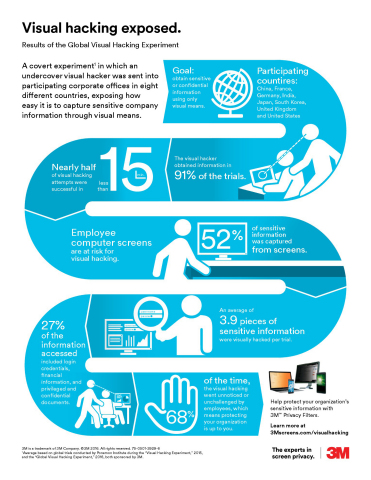New Global Study Reveals Majority of Visual Hacking Attempts Are Successful
Experiments conducted in eight countries reveal high risk of low-tech hacking methods
Organizations around the world are at risk of sharing highly sensitive information through visual hacking in business office
environments. This risk was revealed in the 2016 Global Visual Hacking Experiment, an expansion of the 2015 Visual Hacking Experiment conducted in the United
States by Ponemon Institute and sponsored by 3M Company. The global study included trials in China, France, Germany, India, Japan, South Korea and the United
Kingdom. The combined results found that sensitive information was successfully captured in 91 percent of visual hacking attempts
globally.
This Smart News Release features multimedia. View the full release here: http://www.businesswire.com/news/home/20160810005218/en/

See key findings of the Global experiment as an infographic. (Graphic: 3M)
The global experiments involved 157 trials with 46 participating companies across the eight countries. They exposed low-tech
hacking methods as a significant risk to corporations around the world. The findings revealed that organizations need to create
awareness among employees on protecting data displayed on device screens, as 52 percent of the sensitive information captured
during the experiments came from employee computer screens.
In the experiments, a white hat visual hacker assumed the role of temporary office worker and was assigned a valid security
badge worn in visible sight. The white hat hacker attempted to visually hack sensitive or confidential information using three
methods: walking through the office scouting for information in full view on desks; observing computer monitor screens and other
indiscrete locations like printers and copy machines; taking a stack of business documents labeled as confidential off a desk and
placing it into a briefcase; and using a smartphone to take a picture of confidential information displayed on a computer screen.
All three of these tasks were completed in front of other office workers at each participating company.
Combined average highlights from the 2015 U.S. Visual Hacking study and the 2016 Global Visual Hacking study revealed the
following:
1. Visual hacking is a global problem. Visual hacking occurred in all countries where the experiment was conducted, with
91 percent of attempts being successful.
2. Employee computer screens are most at risk for visual hacking. Globally, 52 percent of sensitive information was
visually hacked from employee computer screens.
3. A company’s most sensitive information is at risk. Of the visually hacked data, 27 percent was considered sensitive
information, including login credentials, attorney-client privileged documents, confidential or classified documents, and financial
information. The information was deemed to be sensitive because of the potential security risk to the organization in the aftermath
of a data-breach incident.
4. Visual hacking happens quickly. It took less than 15 minutes to complete the first visual hack in 49 percent of the
hacking attempts.
5. Office workers are timid about confronting a visual hacker. In 68 percent of the hacking attempts, office personnel
did not question or report the visual hacker even after witnessing unusual or suspicious behavior.
6. Office layout affects visual hacking. Traditional offices and cubicles make it easier to protect paper documents and
more difficult to view a computer screen. In contrast, an open floor plan appears to exacerbate the risk of visual hacking.
7. Companies can take action. The experiment revealed that companies with sound, privacy-control practices experienced 26
percent fewer visual privacy breaches on average.
“The results of these experiments uncover the significant visual privacy risks that all organizations face globally, regardless
of their size, business type or location,” said Dr. Larry Ponemon, founder of Ponemon Institute and chairman of the 3M-sponsored
Visual Privacy Advisory Council. “While visual hacking is often considered a low-tech threat, the repercussions
can be just as detrimental as a high-tech cyberattack.”
As the expert in screen privacy, 3M offers the industry’s broadest line of privacy products to fit most of today’s popular
devices. 3M Visual Privacy solutions can be applied to the screens of desktop monitors, laptops, tablets and smartphones to help
organizations prevent visual hacking by protecting information displayed on screens and help comply with data privacy rules. Learn
more at www.3Mscreens.com.
For more information about the study and how to help prevent visual hacking, visit www.3Mscreens.com/visualhacking to:
- Download the full 2016 Global Visual Hacking Experiment report.
- Download the white paper revealing key findings from the 2016 study.
- Download the 2016 study infographic.
About 3M
At 3M, we apply science in collaborative ways to improve lives daily. With $30 billion in sales, our 90,000 employees connect with
customers all around the world. Learn more about 3M’s creative solutions to the world’s problems at www.3M.com or on Twitter @3M or @3MNewsroom.
3M is a trademark of 3M Company.

PadillaCRT
Heidi Wight, 612-455-1795
heidi.wight@padillacrt.com
View source version on businesswire.com: http://www.businesswire.com/news/home/20160810005218/en/